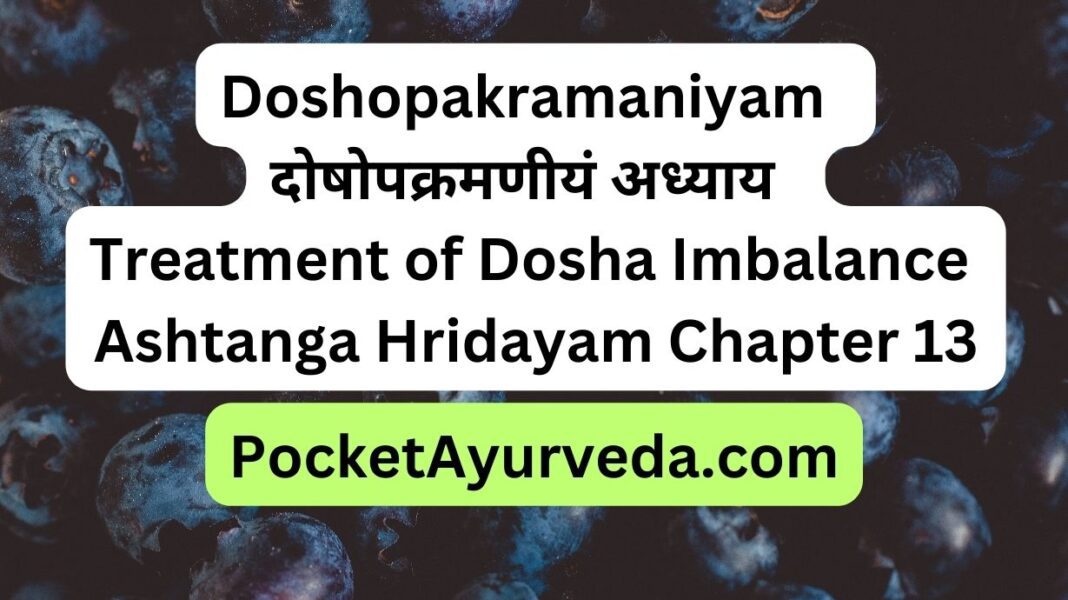In this chapter, we’ll investigate the different treatments for Dosha imbalance and how Tridosha interacts with Ama to cause symptoms and formulate a treatment plan. Additionally, we learn about drug timing based on diseases. It is the 13th chapter of Ashtanga Hrudaya’s Sutrasthana which is known as Doshopakramaneeya Adhyaya.
Vata Vriddhi Chikitsa – Treatment Options for Vata imbalance
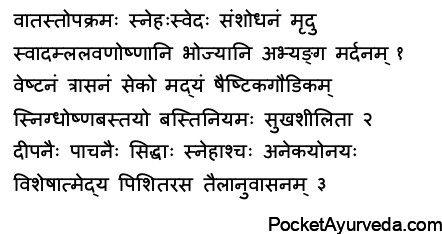

Sneha: Oral administration of oils, ghee and fat with external massage with oil
Sveda Sudation: Diaphoresis and sweating therapy
Mrudu Samshodhana: Mild purification procedure Mild Panchakarma (Vamana and Virechana). An overdose could lead to Vata growth
Svadu Amla Lavana Ushna Bhojya Foods with sweet, sour, and salty flavors; Abhyanga Massage oil, Mardana – simple massage; Veshtana – wrapping or covering organs/body with cloth for protection Trasana (threatening and frightening)
Seka (pouring essential oils or herbal decoctions on the affected part)
Paishtika Goudika Madya (wine made from jaggery and corn flour) – Molasses.
Snigdha Ushna Basti, an enema treatment with fat-oil that contains high-potency Sukhasheelata substances, provides comfort to the patient during times of illness or stress.
Deepana Pachana Siddha Sneha are medicated fats of various kinds that contain substances that stimulate appetite and aid digestion. Medya Pishita Taila Anuvasana Oleation Enema: Made with juice of fatty meats and oil (1-3).
Pitta dosha Vriddhi Chikitsa – Treatment for Pitta Dosha Imbalance


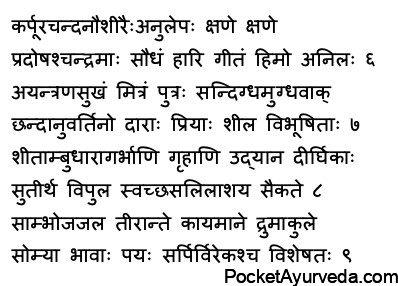

When dealing with an increase in Pitta Dosha, there are several treatments to choose from:
Sarpi Paana: Consumption of Ghrita (clarified butter). Can be simple or medicated depending on medical advice from a doctor.
Sheeta, Svadu Virechana Purgation Therapy Using Sweet-Tasting Drugs and Cold Potency; Intake of drugs and foods that have bitter, sweet or astringent taste. Inhaling the cooling vapors of plants is a wonderful way to relax.
Applying camphor on the body as well as sandalwood paste and Vetiver paste are other common applications.
At night, enjoying moonlit terraces illuminated by moonlight is a pleasure; listening to pleasant music and feeling the chill of the breeze; spending time with friends who won’t let him be restrained; conversing softly and innocently with sons who speak softly in innocence; spending quality time with one’s wife who is loyal and pleasing; sharing meals together.
Living in homes that release cool water from fountains, ponds, and parks;
Staying near reservoirs with pure water, sand, lotus, flowers, and trees; and experiencing the tranquil mind that comes from being near these sources;
Consuming milk, ghee, and the purgation treatment (Virechana);
Kapha dosha Vriddhi Chikitsa – Treatment for Kapha Dosha Imbalance
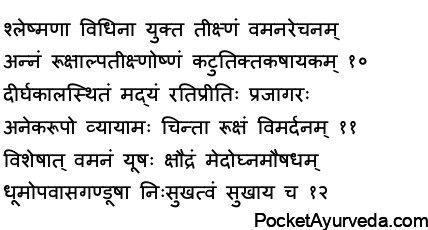

Treating Kapha Imbalances with Kapha Vriddhi Chikitsa
If there is an increase in Kapha Dosha, treatment options include:
Vidhiyukta Teekshna Vamana, Virechana encourages strong emesis and purging in accordance with prescribed procedures. For these individuals, food consumption should be limited to dry items; also limit alcohol intake during this time frame. Foods containing Teekshna (strong and piercing), Ushna (hot) sharp bitter, or astringent tastes; Old wine
Sexual activity
staying awake while sleeping; exercise of all types; worry.
Massage the body dry with Vamana therapy – emesis therapy using grains, or soups as well as honey.
Treatments and medications to help reduce fat, such as inhaling therapeutic smoke, fasting, gargling, facing difficulties 10-12, treatment of combination of doshas


Different treatments exist for each Dosha separately but can also be combined in an effective way when dealing with multiple Doshas simultaneously. 13


Vata Pitta Chikitsa as summer regimen
As with the summer time regimen (Kapha + Vata = Chikitsa), this combination can also be utilized during Vasant. To treat it effectively, follow the same procedures as those outlined for Summertime Vata Pitta Chikitsa as described in Chapter 3.
Combining Kapha with Vata can be likened to Vasanta spring’s Yogavahi routine; when Pitta and Vata are combined together it increases Pitta Dosha. Conversely, when combined with Kapha and Kapha it increases Kapha Dosha.
When treating Kapha and Pitta together, the treatment should be similar to that for Sarad and Autum.14


Treatment in Chaya state
It is recommended to address these doshas during their mild rise phase (Chaya).
At present, when they have reached Kopa (Dosha imbalance), it is recommended that they be defeated without conflict or interfering with one another’s Doshas.


Is Shuddha appropriate, pure, or good?
Pure treatment is when one manages to cure one illness without creating another one. 16
Dosha Gati from Koshta to Shakha – Movement of Dosha from Digestive Tract to Body Tissues and vice versa


Dosha flows from the Digestive Tract to Body Tissues and vice versa; from Koshta to Shakha.
Dosha Gati from Koshta to Shakha
Exercise, temperature increases, and activities that are unwholesome or suitable can cause the movement of Koshta to Shakha due to Vata movement and Doshas accumulation, moving from the digestive tract into Shakha tissues such as Asthi bone or Marmas vital organs or sensitive points.
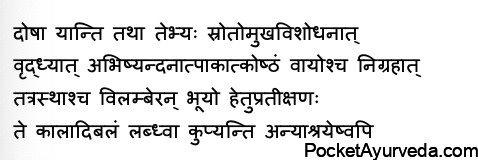

Movement of Dosha from Shakha to Koshta
Moving Doshas from Shakha towards Koshta allows them to traverse body tissues and channels towards digestion. Purification works by clearing away these tiny channels in the body, which allows Doshas to expand further within it and further disrupt its functions. By liquefaction, At the time of maturation. By balancing and controlling Vata, one can achieve equilibrium in their life.
When Doshas move from one location to the next, they often remain there for some time in anticipation of an exciting event. As these energies gain strength through seasons and time, however, they become increasingly stressed and move onto new locations as well. 17-19
Sthayi and Agantu Doshas – Doshas of Native and Foreign Origin


Native and Foreign Doshas, Sthayi- and Agantu Doshas
Special attention must be given to the Dosha that has crossed over into the middle of other Doshas and appears weak since its own power outpaces other Doshas. Priority should also be given to this Dosha for its superior performance.
Agantu Dosha


Foreign Doshas should always be treated after treating native Doshas or alternatively. Ultimately, the decision as to which Dosha to address first depends on both degree of aggravation and strength of both Doshas. 2
Tiryak gata Dosha
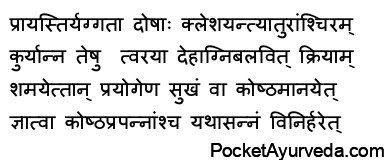

Tiryak gata Doshas that are not located within the digestive tract but instead reside in tissues may cause discomfort to patients for an extended period of time and should not be treated quickly. Instead, it is recommended to assess both physical health and digestion to treat these imbalances.
Palliative therapies or introduction of food into the digestive tract must be used, followed by elimination through nearby methods (either via mouth – using Vamana’s emesis process; or via an oral route through purgation – Virechana). 21-22
Sama Dosha Lakshana : Doshas and their Effects On Ama
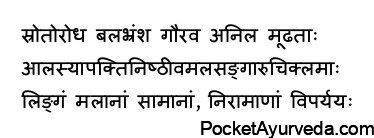

What effects doshas have which are associated with ama?
Effects of Doshas associated with Sama Dosha Lakshana
How to understand these doshas more fully
When Doshas that are imbalanced become associated with Ama (the cause of intoxication or unbalanced metabolism), they are referred to as Saama Dosha. (Sa means ‘with’. The characteristics that arise due to Sama Dosha include:
Balabhramsha: Feeling of weakness; Gaurava: Feeling of weight in the body.
Anila Modata: Lack of activity related to Anila-vata; Alasya: Laziness or lethargy; Apakti: Slight loss in digestive power
Nishteeva: Someone who spits out frequently with saliva, often due to anticipation.
Malasanga: constipation or frequent urination leads to waste accumulation. Aruchi: anorexia
Klama: exhaustion
The opposites of these symptoms are Nirama Doshas (not to be confused with Ama, which is undigested materials) 23-24.
Ritucharya adhyaya ऋतुचर्या Seasonal Regimen : Ashtanga Hridayam Chapter 3
Origin of Ama and Amotpatti


After digestion, the beneficial portion is separated from the waste material. This nutritious, useful portion is known as Rasa Dhatu.
Lacking digestive strength, Rasa Dhatu does not form properly and remains in an uncooked form. This causes it to vitiate and accumulate within Amashaya (stomach and intestinal tract), eventually becoming known as “Ama”. 25


Ama Utpatti
Some researchers have suggested that Ama is formed through an intricate interaction of significantly increased doshas. 26
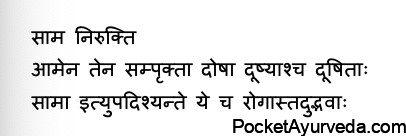

Sama is composed of the Doshas and Dusyas (Dhatus and Malas) which mix with Ama. When combined, these energies become Sama.
Saama Vyadhi refers to illnesses caused by this dosha imbalance. 27
Sama Dosha Chikitsa: Treatment of Sama Doshas:-


Saama Dosha Chikitsa
Sama Doshas that are dispersed throughout the body and hidden within Dhatus cannot be eliminated through purification therapies such as emesis purgations or similar purification methods.
Sama Dosha Treatment with the Right Approach


When treating Sama Dosha, there are several approaches:
First, using drugs that aid digestion and increase appetite;
Subsequently, sudation and oleation treatments such as Snehana and Svedana can be employed; ultimately leading to complete healing of your condition.
Shodhana treatments should then be utilized – purgation and emesis administered at the appropriate time and according to each individual’s strength. 29


Mouth-to-mouth administration of drugs will release Malas and Doshas from the stomach of Amasaya and small intestines.
Inhaling drugs through the nose also draws out Doshas from areas above the shoulders.
Administering medicines through the rectum draws out Doshas through Pakvasaya – large intestinal. 30


Saama Doshas are substantially multiplied and have the capacity to leave the body on their own, either through vomiting or purging. Drugs should never be used as a way to stop these processes as even when removed may still cause illness. 31


In the beginning, doshas that are being released must not be ignored and patients given appropriate food – light foods;
In a subsequent stage, food should be cooked using digestive drugs or removed through purification treatments such as Panchakarma. 32
Time for eliminating Dosha from the body


Time for purging Dosha
Vata which tends to increase during Greeshma (summer) must be eliminated from the body with basti-enema during Shravana masa (August).
Kapha, which tends to increase mildly during Shishira (winter), should be expelled from the body during Chaitra month (April) by Vamana. 33
Shodhana kala – Time for Eliminating Doshas by Panchakarma


Greeshma, Varsa, and Hemanta (summer, rainy season, and winter) have extreme temperatures – cold as well as rain; this condition is known as Sadharana Kala and must be addressed in order to eradicate its causes. 34


After managing the effects of hot, cold, and rainy seasons with proper protection methods, therapy is then recommended for treatment.
Kriyakala is periods of inactivity or abnormal health conditions that must not be allowed to continue their course.
Aushadha Sevana Kala – Administration Time of Medicines
Aushadha Sevana Kala: When to Take This Medication
When should you take Aushadha Sevana Kala?
The dosage should be taken as prescribed.


Medicines should be administered,
1. ananna – on empty / when there is no food- in the stomach ; 2. annadau – just before food or at the beginning of food intake, 3. anna madhye – during / in between food intake
4. anna ante – at the end of food intake.
5. kavalantare – in between morsels
6. grase grase – with each morsel
7. muhu: – repeatedly, many a times a day
8. sa annam – mixed with food
9. samudgam – before and after food
10 nishi – at night, bed time
Aushadha Sevana Kala – Time of Administration of Medicines
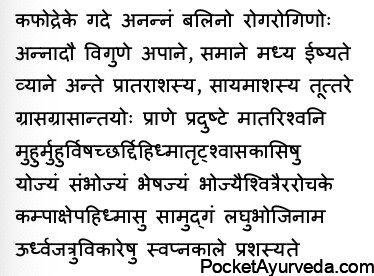

Medicines should be administered,
1. Ananna – on empty stomach – For diseases arising from increase of Kapha, which are severe and for persons who are strong, the time of administration of medicine shall be when there is no food- in the stomach ;
2. Annadau – just before food or at the beginning of food intake – in disorders of Apanavata,
3. Anna Madhye – During / in between food intake – in disorders of Samana vata
4. Anna ante – at the end of food intake – in disorders of Vyana vata at the end of the morning meal, in disorders of Udana vata at the end of evening meal.
5. Kavalantare – in between morsels – in disorders of Prana- vata
6. Grase Grase – With each morsel – in anorexia, loss of taste it shall be mixed with different kinds of tasty foods
7. Muhu: – Repeatedly, many a times a day – in diseases produced by poison, vomiting, hiccup, thirst, dysponea and cough
8. Sa annam – Mixed with food – in anorexia
9. Samudgam – before and after food – in tremors, Akshepaka (convulsions), Hiccup,
10 Nishi – at night, bed time – for diseases affecting head and neck. 37
Thus concludes Chapter 13.
FAQ’s of Doshopkramaniya Adhyaya
what is the treatment options for vata dosha vriddhi chikitsa?
sneha,sveda,mrudu samshodhana,svadu amla lavana ushna bhojya foods,abhyanga,mardana,trasana,seka,snigdha ushna basti,sukhasheelata, deepana pachana siddha sneha
what is the treatment options for pitta dosha vriddhi chikitsa?
sarpi pana, sheeta svadu virechana therapy, bitter sweet astrigent taste food,milk ghee and virehana
what is the treatment options for kapha dosha vriddhi chikitsa?
teekshna vamana virechana, teekshna ushna sharp bitter or astringent taste food old wine, sexual activity, fasting, gargling
what is the best time for vamana karma?
Chaitra month April
what is the best time for basti karma?
Greeshma Summer, August


